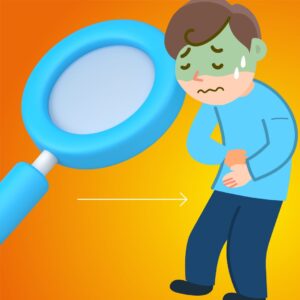As the summer sun graces us with its warm embrace, it’s easy to forget that the season also brings its own set of health challenges, including the elusive summer cold. While we typically associate being sick with chilly weather, the summer can catch us off guard. By staying informed and seeking appropriate care, you can better protect your immune system and its long-term resilience, ensuring a healthier future despite encountering the unique challenges of the current infection.
What the Summer of 2023 Infection Looks Like
 During the summer of 2023, a peculiar wave of cold-like symptoms emerged, gaining traction from the early days of June through August. These symptoms can manifest differently among individuals, beginning with a general feeling of being unwell and fatigued, accompanied by a clear awareness of being under the weather. Within a day of onset, additional discomforts start to appear, such as a sore and scratchy throat, parched mouth, a persistently dry cough, headaches, intermittent waves of heat, queasiness, vomiting, loss of appetite, congested sinuses, and a mild fever.
During the summer of 2023, a peculiar wave of cold-like symptoms emerged, gaining traction from the early days of June through August. These symptoms can manifest differently among individuals, beginning with a general feeling of being unwell and fatigued, accompanied by a clear awareness of being under the weather. Within a day of onset, additional discomforts start to appear, such as a sore and scratchy throat, parched mouth, a persistently dry cough, headaches, intermittent waves of heat, queasiness, vomiting, loss of appetite, congested sinuses, and a mild fever.
The complexity of these symptoms is such that various components can escalate to a point where they mimic the conditions like pneumonia or perplexing digestive disorders, leading individuals on an urgent trip to the emergency room. It’s persistence is truly remarkable, often making a comeback just when you start to believe you’re on the mend, or displaying a stubborn resistance to departure. The resistant and headstrong nature of this infection highlights the need for a deeper understanding, as well as innovative approaches to both short-term relief and long-term management.
Unmasking the Villain: The Spike Protein
We may be relieved that discussions about Covid have dwindled, and the desire to move on is entirely understandable. However, I believe it’s essential to revisit Covid-19 for a moment because I’ve developed a theory concerning potential long-term health consequences stemming from recurrent infections with a specific component of the virus, known as the Spike Protein. While it might be tempting to put the pandemic behind us entirely, understanding this aspect could shed light on broader health implications beyond the immediate concerns surrounding Covid.
The spike protein, a critical component of Covid-19, has emerged as a key player in the complex dance between the virus and the human body. With its distinctive structure resembling a crown, this protein enables the virus to latch onto human cells, facilitating infection. While much attention has been directed towards its role in transmission, emerging research suggests that the spike protein may have more profound and potentially long-lasting effects on our body beyond the initial infection.
This has brought forth concerns about the damage the spike protein could cause, not only during the acute phase of the illness but also in the realm of lingering health impacts. My Youtube episode, “The 5 Ways the Spike Can Harm Your Body,” or the Senate Commissioned report on the Origins of Covid-19. It is a 300 page report gives an introduction to the issues of the spike protein.
Tracking Covid in the Era of Variants
Navigating the current state of Covid has become a complex challenge. The straightforward methods we once relied on to monitor the virus’s trajectory are no longer available. Instead, staying informed involves a nuanced approach characterized by monitoring wastewater statistics and staying attuned to international news.
 By closely watching these indicators, we gain valuable insights into new variants and the journey toward the United States. The overseas updates act as a crystal ball, showing when the next wave may arrive on our shores. Meanwhile, the wastewater statistics become our local compass, revealing the early signs of rising Covid levels within our communities. Adapting and embracing these unconventional methods in this shifting landscape empowers us to respond proactively as the pandemic’s patterns evolve.
By closely watching these indicators, we gain valuable insights into new variants and the journey toward the United States. The overseas updates act as a crystal ball, showing when the next wave may arrive on our shores. Meanwhile, the wastewater statistics become our local compass, revealing the early signs of rising Covid levels within our communities. Adapting and embracing these unconventional methods in this shifting landscape empowers us to respond proactively as the pandemic’s patterns evolve.
The XBB variant became known in India in April, prompting heightened attention across the country’s healthcare infrastructure. In India, officials swiftly identified the variant as exceptionally contagious, raising concerns within the healthcare community. This revelation sparked a closer look at Covid-19, revealing a surprising aspect: research indicates that approximately 50% of infected individuals display no symptoms, which has significant implications for transmission. What stands out from India’s experience with this variant is that, despite its high contagiousness, there was no evidence of a concurrent increase in hospitalization or mortality rates.
A few months later, in June, a subtle but noticeable increase in wastewater Covid levels in the US was observed, and levels continued to increase into August. This timely and proactive monitoring, including wastewater analysis, plays a crucial role in helping us stay informed about the virus’s activity in our communities, ensuring that we remain prepared to address any potential challenges in public health.
In June, a noticeable trend emerged with those falling ill with symptoms primarily affecting the head, throat, and lungs, hinting that may be the hallmark of the XBB.1.16 variant that was circulating in India in April. However, as August rolled in, a notable shift occurred, introducing severe digestive symptoms and a strong sense that something was internally wrong. This development suggests the possibility of a new variant. The EG.5 variant is new and gaining a foothold in the U.S.
“(EG.5 variant) are only slightly more resistant to neutralizing antibodies in serum of infected and vaccinated persons,” said Dr. David Ho has been testing these variants in his lab at Columbia University.
Has the Pandemic Changed Our Immune System?
In the past months, something has felt different, and I can’t help but notice a dramatic increase in people and clients falling ill. This trend of illnesses is broad. It encompasses new and worrisome conditions like cancer, diabetes, cardiovascular disease, high blood pressure, and digestive issues such as IBS and Crohn’s.
And some of these illnesses have not been following the rules we’ve established in regular Western Medicine. I highlight that in my episode, “Sepsis Epidemic, What You Need to Know to Protect Yourself.” Where we review the labs of individuals who have sepsis and are not testing for a viral or bacterial infection.
According to John Hopkins Medicine,
“Septicemia, or sepsis, is the clinical name for blood poisoning by bacteria. It is the body’s most extreme response to an infection. Sepsis that progresses to septic shock has a death rate as high as 50%, depending on the type of organism involved.”
Getting into your regular Western medicine doctor has been a nightmare. Initially, I attributed the difficulties in accessing medical care to people returning to healthcare after the pandemic. But as the problems continued and seem to be getting worse, I thought it was due to understaffing and shifting scheduling processes at the doctor’s office. Now, I’m starting to believe it is the increase in post-pandemic health issues. Just the magnitude of individuals getting new disease diagnoses or progression of existing diseases appears to be exploding.
It’s as if there’s been a significant shift in our immune systems since the pandemic began, prompting me to wonder about the underlying causes of this unsettling change in health trends.
Research from the VA Administration on Long-term Consequences
What are the implications to your health over the longterm? One of the first research studies that finally gave credence to what I saw in the clinic was a Veterans Administration study. The Veteran’s Administration research spells out COVID’s down-the-road risks for cardiovascular and mental health.
“For many people, COVID-19 infection comes with only mild or moderate symptoms, such as an irkesome cough and shortness of breath that last for a few days. But this first phase can be the ‘tip of the iceberg,’…COVID can affect nearly every organ system. People return to their doctor with fatigue, brain fog, amnesia, strokes, new-onset diabetes, kidney disease, heart disease, and more.”
Because of the range of chronic symptoms that could come from even a mild infection, the researchers zero’d in on cardivascular health and mental health. In these two categories, they found,
“(1)Overall, those with COVID were 55 percent more likely than the non-COVID group to suffer a major adverse cardiovascular event such as heart attack, stroke, or death…
(2) Compared to those who did not have COVID, those in the COVID group had a 60 percent higher risk of having any mental health disorder or mental health-related prescriptions.”
Here was evidence that infection with Covid was causing significant changes to our immune system that progress over time. But, what was causing the changes in our immune system?
The Spike Protein: Implications for Health and Recovery
 At the heart of it lies a critical element: the spike protein. What’s fascinating is that when you delve into the extensive body of research, it becomes evident that the focus is on this particular component. The spotlight has been firmly fixed on the spike protein, garnering attention from researchers and scientists across the globe.
At the heart of it lies a critical element: the spike protein. What’s fascinating is that when you delve into the extensive body of research, it becomes evident that the focus is on this particular component. The spotlight has been firmly fixed on the spike protein, garnering attention from researchers and scientists across the globe.
While the entire virus is complex, the spike protein seems to hold the key to understanding its behavior and interactions with the human body. The selective emphasis from science on the spike protein reveals its pivotal role and potential implications for our health.
This prompts me to consider the importance of taking proactive measures for my well-being, specifically the removal of the spike protein from my body. Unlike the flu virus, which infects cells that are then targeted by the immune system and eventually expelled, leading to a full recovery, the spike protein operates in a distinct manner. It doesn’t adhere to the typical viral playbook. Instead of just infecting cells and being expelled like the flu virus, it damages our organs and tissues. It has the ability to escape from cells. Although our immune system strives to counter it, the research suggests that this infection doesn’t adhere to the traditional rules of the immune system and can continue causing issues in the body long after the initial infection.
I become apprehensive when a fresh version of Covid emerges because each of us gets another dose of spike protein. It appears the damage it inflicts may accrue over time. These new spike proteins seem to pick up where the previous ones left off. Research from the Veteran’s Administration suggests that there is an ongoing process of internal damage even after we believe we’ve recovered. Despite being deemed healed, we may not fully return to our original state of health, experiencing lingering effects from the illness like fatigue or brain fog.
Healing from Within: A Vital Step Towards Healing and Health
 If we’ve been working together at the clinic on getting rid of the spike protein, you might notice some of your symptoms come back when you get reinfected with a new variant – especially bloating. If you’re curious about some of the symptoms that may be related to the spike protein, I have a helpful download you can get for free by clicking here. It’s a resource that explains what I’ve been observing in the clinic.
If we’ve been working together at the clinic on getting rid of the spike protein, you might notice some of your symptoms come back when you get reinfected with a new variant – especially bloating. If you’re curious about some of the symptoms that may be related to the spike protein, I have a helpful download you can get for free by clicking here. It’s a resource that explains what I’ve been observing in the clinic.
Avoiding these infections is getting harder because Covid-19 is now considered endemic, meaning it’s always around. So the next best thing is finding ways to protect your health and detox your body from the spike protein.
I’ve found that Chinese herbal medicine has been effective treating the virus. With the latest August variant, I haven’t seen severe cases where clients couldn’t eat and needed to go to the ER. Chinese herbs can help with an acute infection because the herbs support your immune system in pulling the harmful stuff out of the body instead of suppressing the symptoms. If you need help supporting your immune system, schedule an online appointment here.
 However, when it comes to the spike protein, we’re not entirely sure how long it stays in the body or what it’s doing. This requires a longer-term strategy. Even though Western Medicine often masks the symptoms enabling the spike protein to continue to cause damage in your body, Western Medicine can give you time to figure out how to heal or reduce the damage.
However, when it comes to the spike protein, we’re not entirely sure how long it stays in the body or what it’s doing. This requires a longer-term strategy. Even though Western Medicine often masks the symptoms enabling the spike protein to continue to cause damage in your body, Western Medicine can give you time to figure out how to heal or reduce the damage.
You might be experiencing new health issues or a worsening of existing ones. If that is you, it may be a good time to focus on other ways to heal your body. Joining HealthHub can help you bridge the gap between the latest research and holistic steps you can take to repair your body. If you want to join or learn more about HealthHub, you can click here to gain better control and understanding of your health.

